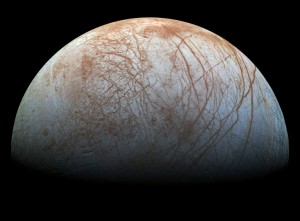22 December 2014
Veteran geophysical tool preps for new horizons at Europa
Posted by kwheeling
By Kerry Klein

Researchers from MIT and NASA hope that their imaging instrument will be selected for a flyby mission of Jupiter’s moon Europa.
Credit:ASA/JPL/SETI Institute
Jupiter’s moon Europa has tantalized scientists with its potential for harboring life ever since Galileo first spotted the icy satellite in 1610. If living matter is bubbling anywhere in our solar system, they suspect, it would be below the moon’s icy shell, where a presumed ocean of salty water meets a mineral-rich interior.
But because scientists can’t peer beneath the ice, they must rely on data beamed back by passing spacecraft. A proposed NASA mission called Europa Clipper could be sent to the moon in the next decade—and researchers from the Massachusetts Institute of Technology and NASA want their instrument to be onboard.
NASA planetary scientist Gregory Neumann and his colleagues are constructing a laser altimeter, a device that pings a surface with infrared signals and creates a 3-dimensional image with the information it receives back. Laser altimeters have already proven useful in peering up-close at Mars, Mercury and our own moon, and Neumann and his team are hard at work designing one for Europa Clipper.
The spacecraft is slated to observe Europa from Jupiter’s orbit. Over the course of three and a half years, the probe would make around 45 flybys of the moon, gleaning information about its geology, atmospheric chemistry and tidal motion, sometimes called ice tectonics.
“Laser altimeters are the ideal instrument for measuring that kind of tectonic deformation,” said Neumann. “You can make measurements to the centimeter level.”
Laser altimetry would complement onboard cameras with information necessary to create a 3-dimensional map of the moon’s entire surface. Neumann is even hoping for a glimpse of water plumes detected by the Hubble Space Telescope in 2013.
“The presumption is that we might get lucky and see one,” he said.
But researchers can’t just make a replica of the altimeters already in use in space. Each planetary body has its own associated risks. For instance, the altimeter on the MESSENGER spacecraft in orbit around Mercury must be able to withstand daytime temperatures upward of 800 degrees Fahrenheit (427 degrees Celsius), while the temperature at Europa averages closer to -260 degrees Fahrenheit (-160 degrees Celsius).
The spacecraft must also survive high temperatures used to sterilize it of all life forms from Earth in case it crash lands on the moon. Additionally, a spacecraft in orbit around Jupiter must be able to withstand the planet’s belts of radiation, thousands to millions of times stronger than those around the Earth.
“The electronics are about as simple as your early Radioshack computers,” Neumann said, “but they’ve been radiation hardened so that they will work in that environment.”
There’s no guarantee the team’s laser altimeter will be onboard when the Europa Clipper launches, which could come in the year 2022 at the earliest, Neumann said. The instrument is one of dozens of proposals vying for limited space on the probe.
But Neumann isn’t worried.
“Our chances are excellent,” he said. “We’re the best.”
-Kerry Klein is a science communication graduate student at UC Santa Cruz










 GeoSpace is a blog on Earth and space science, managed by AGU’s Public Information staff. The blog features posts by AGU writers and guest contributors on all sorts of relevant science topics, but with a focus on new research and geo and space sciences-related stories that are currently in the news.
GeoSpace is a blog on Earth and space science, managed by AGU’s Public Information staff. The blog features posts by AGU writers and guest contributors on all sorts of relevant science topics, but with a focus on new research and geo and space sciences-related stories that are currently in the news.